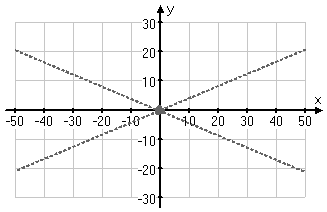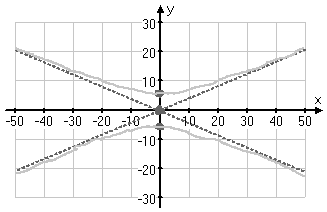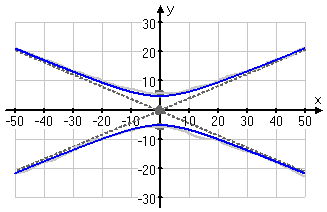Extracting Information from the Hyperbola's Equation
Purplemath
It is fairly easy to find loads of examples online of real-world uses for the other conics; namely, for circles, parabolas, and ellipses. It is more difficult to find examples of real-world uses for hyperbolas.
And, unfortunately, many of the examples listed online are simply wrong.
Content Continues Below
For instance, rainbows are arcs of circles. A chain hanging between two supports forms a catenary. Satellite dishes are parabolic surfaces. And so forth.
What are some real-life examples of hyperbolas?
The following are real-world examples of hyperbolas:
- certain optical lenses, such as those used to create panoramic pictures
- certain head-mounted displays
- a type of gear, invented in 1924, used, for example, in vehicle transmissions
- loran, tdoa, and other navigation methods
- some cooling towers
- the path of the tip of the shadow on a sundial, as can be shown by real-life measurements
Affiliate
If you are needing real-world examples of hyperbolas, do your research; make sure that you can find non-math-class-based documentation of the claimed use.
In your math class, you will be expected to be able to extract information about a given hyperbola from its equation. Below are a few examples of how this works.
- Find the center, vertices, foci, eccentricity, and asymptotes of the hyperbola with the given equation, and sketch:
Since the y part of the equation is added, then the center, foci, and vertices will be above and below the center, on a line paralleling the y-axis, rather than side by side.
Looking at the denominators, I see that a2 = 25 and b2 = 144, so a = 5 and b = 12.
The equation c2 = a2 + b2 tells me that
c2 = 144 + 25 = 169
c = 13
(Recall that c is a length, so its value must be positive.)
Then the eccentricity is given by:
Since x2 = (x − 0)2 and y2 = (y − 0)2, then the center is at (h, k) = (0, 0).
The vertices and foci are above and below the center, so the foci are at (0, −13) and (0, 13), and the vertices are at (0, 5) and (0, −5).
Because the y part of the equation is dominant (being added, not subtracted), then the slope of the asymptotes has the a on top, so the slopes will be .
For my sketch, I start with the center, and draw the asymptotes through it, using dashed lines:

Then I draw in the vertices, and rough in the graph, rotating the paper as necessary and "eye-balling" for smoothness:

Then I draw in the final graph as a neat, smooth, heavier line:

And the rest of my answer is:
center: (0, 0)
vertices: (0, −5) and (0, 5)
foci: (0, −13) and (0, 13)
eccentricity:
asymptotes:
Content Continues Below
- Give the center, vertices, foci, and asymptotes for the hyperbola with equation
Since the x part is added, then a2 = 16 and b2 = 9, so a = 4 and b = 3.
Also, this hyperbola's foci and vertices are to the left and right of the center, on a horizontal line paralleling the x-axis.
From the equation, clearly the center is at (h, k) = (−3, 2).
Since the vertices are a = 4 units to either side, then they are at the points (−7, 2) and at (1, 2).
The equation a2 + b2 = c2 gives me:
c2 = 9 + 16 = 25
c = 5
Then the foci, being 5 units to either side of the center, must be at (−8, 2) and (2, 2).
Since the a2 went with the x part of the equation, then a is in the denominator of the slopes of the asymptotes, giving me:
Keeping in mind that the asymptotes go through the center of the hyperbola, the asymptes are then given by the following straight-line equations:
Putting it all together, my answer is:
center: (−3, 2)
vertices: (−7, 2) and (1, 2)
foci: (−8, 2) and (2, 2)
asymptotes:
Depending upon your textbook and instructor, you might be expected to convert the asymptote equations into the two separate line equations, by multiplying through by the "plus" and the "minus". Follow the lead of whatever your instructor does at the board.
- Find the center, vertices, and asymptotes of the hyperbola with equation 4x2 − 5y2 + 40x − 30y − 45 = 0.
To find the information I need, I'll first have to convert this equation to vertex form by completing the square. The following are my steps in that process, starting with grouping the x- and y-containing terms together, and moving the loose number to the other side of the "equals" sign:
4x2 + 40x − 5y2 − 30y = 45
4(x2 + 10x ) − 5(y2 + 6y ) = 45 + 4( ) − 5( )
4(x2 + 10x + 25) − 5(y2 + 6y + 9) = 45 + 4(25) − 5(9)
4(x + 5)2 − 5(y + 3)2 = 45 + 100 − 45
Affiliate
Now that I've converted the equation from multiplied-out form to center-vertex form, I can start extracting information.
The center is at (h, k) = (−5, −3).
Since the x-part of the equation is added, then the center, foci, and vertices lie on a horizontal line paralleling the x-axis. From the denominators, I get a2 = 25 and b2 = 20, so a = 5 and . The equation a2 + b2 = c2 gives me:
c2 = 25 + 20 = 45
The slopes of the two asymptotes will be , so the asymptotes' equations are given by:
Then my complete answer is:
center: (−5, −3)
vertices: (−10, −3) and (0, −3)
foci: and
asymptotes:
Note: If I had needed to graph this hyperbola, I'd have used a decimal approximation of ± 0.89442719... for listing the slopes, but would have rounded the value to something reasonable like m = ± 0.9 for graphing the dashed lines.
You can use the Mathway widget below to practice converting expanded hyperbola equations into conics, or vertex, form. (Or skip the widget and continue with the lesson.) Try the entered exercise, or type in your own exercise. Then click the button and select "Find the Vertex Form" to compare your answer to Mathway's.
Please accept "preferences" cookies in order to enable this widget.
(Click "Tap to view steps" to be taken directly to the Mathway site for a paid upgrade.)
- A sundial has a gnomon, the tip of whose shadow traces out a line corresponding to the lower branch of the hyperbola given by the equation 13y2 − 36x2 = 1872. Find the location of the tip of the shadow at noon, relative to the tip of the gnomon.
First, I'll need to put this equation into conics form, by completing the square. (In this case, all I'll need to do is divide through by 1872.)
Advertisement
So clearly the center of this hyperbola is at the origin; also, a2 = 144 and b2 = 52. Since the y-part is added in the equation, then the branches are indeed upper and lower; I'll be working with the lower branch.
The tip of the gnomon (NOH-munn, being the stick or pointer that casts the shadow) will be at (well, floating the air above) the focus of the lower branch; the tip of its shadow *at noon* will be at the vertex of the lower branch. So I need to find the lower vertex and the lower focus. For this, I'll need the value of c.
c2 = 144 + 52 = 196
c = 14
The vertex will be a units below the center; the focus will be c units below the center. So the tip of the shadow will be at (0, −a) = (0, −12), and the gnomon will be at (0, −c) = (0, −14).
But they didn't ask me for the algebraic locations; they asked me for the location of the shadow's tip relative to the location of the gnomon. And, looking at the points, I can see that my answer should be:
The shadow's tip is 2 units above the gnomon.
URL: https://www.purplemath.com/modules/hyperbola2.htm
Select a Course Below
Standardized Test Prep
Homeschool Math
© 2024 Purplemath, Inc. All right reserved. Web Design by ![]()




